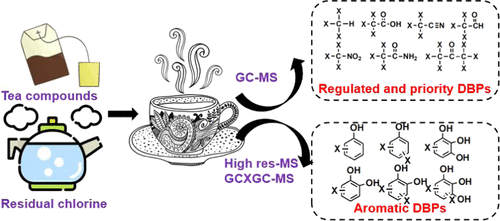当前位置:
X-MOL 学术
›
Environ. Sci. Technol.
›
论文详情
Our official English website, www.x-mol.net, welcomes your feedback! (Note: you will need to create a separate account there.)
Are Disinfection Byproducts (DBPs) Formed in My Cup of Tea? Regulated, Priority, and Unknown DBPs
Environmental Science & Technology ( IF 11.4 ) Pub Date : 2021-09-15 , DOI: 10.1021/acs.est.1c03419 Jiafu Li 1, 2 , Md Tareq Aziz 1 , Caroline O Granger 1 , Susan D Richardson 1
Environmental Science & Technology ( IF 11.4 ) Pub Date : 2021-09-15 , DOI: 10.1021/acs.est.1c03419 Jiafu Li 1, 2 , Md Tareq Aziz 1 , Caroline O Granger 1 , Susan D Richardson 1
Affiliation

|
Globally, tea is the second most consumed nonalcoholic beverage next to drinking water and is an important pathway of disinfection byproduct (DBP) exposure. When boiled tap water is used to brew tea, residual chlorine can produce DBPs by the reaction of chlorine with tea compounds. In this study, 60 regulated and priority DBPs were measured in Twinings green tea, Earl Grey tea, and Lipton tea that was brewed using tap water or simulated tap water (nanopure water with chlorine). In many cases, measured DBP levels in tea were lower than in the tap water itself due to volatilization and sorption onto tea leaves. DBPs formed by the reaction of residual chlorine with tea precursors contributed ∼12% of total DBPs in real tap water brewed tea, with the remaining 88% introduced by the tap water itself. Of that 12%, dichloroacetic acid, trichloroacetic acid, and chloroform were the only contributing DBPs. Total organic halogen in tea nearly doubled relative to tap water, with 96% of the halogenated DBPs unknown. Much of this unknown total organic halogen (TOX) may be high-molecular-weight haloaromatic compounds, formed by the reaction of chlorine with polyphenols present in tea leaves. The identification of 15 haloaromatic DBPs using gas chromatography–high-resolution mass spectrometry indicates that this may be the case. Further studies on the identity and formation of these aromatic DBPs should be conducted since haloaromatic DBPs can have significant toxicity.
中文翻译:

我的一杯茶中是否会形成消毒副产品 (DBP)?受管制的、优先的和未知的 DBP
在全球范围内,茶是仅次于饮用水的第二大消费非酒精饮料,是消毒副产品 (DBP) 暴露的重要途径。当用煮沸的自来水泡茶时,余氯会通过氯与茶化合物的反应产生 DBP。在这项研究中,在使用自来水或模拟自来水(含氯的纳米纯水)冲泡的川宁绿茶、伯爵茶和立顿茶中测量了 60 种受监管和优先的 DBP。在许多情况下,由于挥发和吸附在茶叶上,茶中测得的 DBP 水平低于自来水本身。残留氯与茶前体反应形成的 DBPs 占真正自来水冲泡茶中 DBPs 总量的 12%,其余 88% 由自来水本身引入。在这 12% 中,二氯乙酸、三氯乙酸和氯仿是唯一的 DBP。与自来水相比,茶叶中的总有机卤素几乎翻了一番,其中 96% 的卤化 DBP 未知。这种未知的总有机卤素 (TOX) 中的大部分可能是高分子量卤代芳烃化合物,由氯与茶叶中存在的多酚反应形成。使用气相色谱-高分辨质谱鉴定 15 种卤代芳烃 DBP 表明可能是这种情况。应进一步研究这些芳香 DBP 的特性和形成,因为卤代芳香 DBP 可能具有显着的毒性。这种未知的总有机卤素 (TOX) 中的大部分可能是高分子量卤代芳烃化合物,由氯与茶叶中存在的多酚反应形成。使用气相色谱-高分辨质谱鉴定 15 种卤代芳烃 DBP 表明可能是这种情况。应进一步研究这些芳香 DBP 的特性和形成,因为卤代芳香 DBP 可能具有显着的毒性。这种未知的总有机卤素 (TOX) 中的大部分可能是高分子量卤代芳烃化合物,由氯与茶叶中存在的多酚反应形成。使用气相色谱-高分辨质谱鉴定 15 种卤代芳烃 DBP 表明可能是这种情况。应进一步研究这些芳香 DBP 的特性和形成,因为卤代芳香 DBP 可能具有显着的毒性。
更新日期:2021-10-06
中文翻译:

我的一杯茶中是否会形成消毒副产品 (DBP)?受管制的、优先的和未知的 DBP
在全球范围内,茶是仅次于饮用水的第二大消费非酒精饮料,是消毒副产品 (DBP) 暴露的重要途径。当用煮沸的自来水泡茶时,余氯会通过氯与茶化合物的反应产生 DBP。在这项研究中,在使用自来水或模拟自来水(含氯的纳米纯水)冲泡的川宁绿茶、伯爵茶和立顿茶中测量了 60 种受监管和优先的 DBP。在许多情况下,由于挥发和吸附在茶叶上,茶中测得的 DBP 水平低于自来水本身。残留氯与茶前体反应形成的 DBPs 占真正自来水冲泡茶中 DBPs 总量的 12%,其余 88% 由自来水本身引入。在这 12% 中,二氯乙酸、三氯乙酸和氯仿是唯一的 DBP。与自来水相比,茶叶中的总有机卤素几乎翻了一番,其中 96% 的卤化 DBP 未知。这种未知的总有机卤素 (TOX) 中的大部分可能是高分子量卤代芳烃化合物,由氯与茶叶中存在的多酚反应形成。使用气相色谱-高分辨质谱鉴定 15 种卤代芳烃 DBP 表明可能是这种情况。应进一步研究这些芳香 DBP 的特性和形成,因为卤代芳香 DBP 可能具有显着的毒性。这种未知的总有机卤素 (TOX) 中的大部分可能是高分子量卤代芳烃化合物,由氯与茶叶中存在的多酚反应形成。使用气相色谱-高分辨质谱鉴定 15 种卤代芳烃 DBP 表明可能是这种情况。应进一步研究这些芳香 DBP 的特性和形成,因为卤代芳香 DBP 可能具有显着的毒性。这种未知的总有机卤素 (TOX) 中的大部分可能是高分子量卤代芳烃化合物,由氯与茶叶中存在的多酚反应形成。使用气相色谱-高分辨质谱鉴定 15 种卤代芳烃 DBP 表明可能是这种情况。应进一步研究这些芳香 DBP 的特性和形成,因为卤代芳香 DBP 可能具有显着的毒性。


























 京公网安备 11010802027423号
京公网安备 11010802027423号